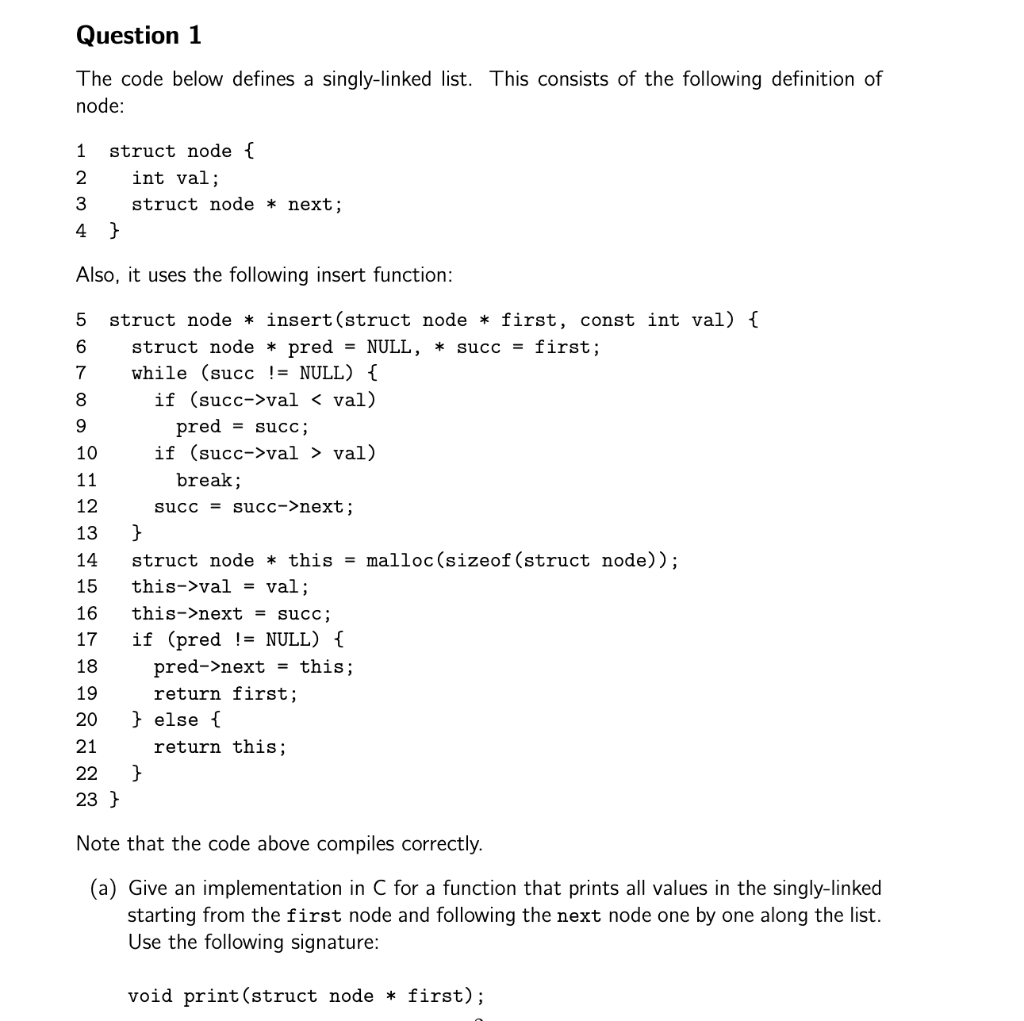Note that the code above compiles correctly. (a) Give an implementation in C for a function that prints all values in the singly-linked starting from the first node and following the next node one by one along the list. Use the following signature: void print(struct node * first);
Note that the code above compiles correctly. (a) Give an implementation in C for a function that prints all values in the singly-linked starting from the first node and following the next node one by one along the list. Use the following signature: void print(struct node * first);
Computer Networking: A Top-Down Approach (7th Edition)
7th Edition
ISBN:9780133594140
Author:James Kurose, Keith Ross
Publisher:James Kurose, Keith Ross
Chapter1: Computer Networks And The Internet
Section: Chapter Questions
Problem R1RQ: What is the difference between a host and an end system? List several different types of end...
Related questions
Question

Transcribed Image Text:Question 1
The code below defines a singly-linked list. This consists of the following definition of
node:
1
struct node {
int val;
struct node * next;
4 }
Also, it uses the following insert function:
struct node * insert(struct node * first, const int val) {
6
struct node * pred = NULL, *
succ = first;
7
while (succ != NULL) {
8
if (succ->val < val)
pred = succ;
if (succ->val > val)
10
11
break;
12
succ = succ->next;
13
}
struct node * this = malloc(sizeof (struct node));
this->val = val;
14
15
16
this->next = succ;
17
if (pred != NULL) {
pred->next
return first;
} else {
18
this;
%3D
19
20
21
return this;
22
}
23 }
Note that the code above compiles correctly.
(a) Give an implementation in C for a function that prints all values in the singly-linked
starting from the first node and following the next node one by one along the list.
Use the following signature:
void print (struct node * first);
Expert Solution
This question has been solved!
Explore an expertly crafted, step-by-step solution for a thorough understanding of key concepts.
Step by step
Solved in 3 steps with 1 images

Recommended textbooks for you

Computer Networking: A Top-Down Approach (7th Edi…
Computer Engineering
ISBN:
9780133594140
Author:
James Kurose, Keith Ross
Publisher:
PEARSON

Computer Organization and Design MIPS Edition, Fi…
Computer Engineering
ISBN:
9780124077263
Author:
David A. Patterson, John L. Hennessy
Publisher:
Elsevier Science

Network+ Guide to Networks (MindTap Course List)
Computer Engineering
ISBN:
9781337569330
Author:
Jill West, Tamara Dean, Jean Andrews
Publisher:
Cengage Learning

Computer Networking: A Top-Down Approach (7th Edi…
Computer Engineering
ISBN:
9780133594140
Author:
James Kurose, Keith Ross
Publisher:
PEARSON

Computer Organization and Design MIPS Edition, Fi…
Computer Engineering
ISBN:
9780124077263
Author:
David A. Patterson, John L. Hennessy
Publisher:
Elsevier Science

Network+ Guide to Networks (MindTap Course List)
Computer Engineering
ISBN:
9781337569330
Author:
Jill West, Tamara Dean, Jean Andrews
Publisher:
Cengage Learning

Concepts of Database Management
Computer Engineering
ISBN:
9781337093422
Author:
Joy L. Starks, Philip J. Pratt, Mary Z. Last
Publisher:
Cengage Learning

Prelude to Programming
Computer Engineering
ISBN:
9780133750423
Author:
VENIT, Stewart
Publisher:
Pearson Education

Sc Business Data Communications and Networking, T…
Computer Engineering
ISBN:
9781119368830
Author:
FITZGERALD
Publisher:
WILEY